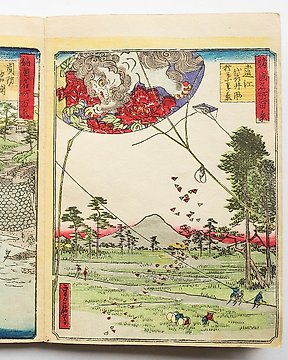
Hiroshige 歌川 広重 (1797-1858) / Hiroshige II 二代目 歌川広重 (1826-1869) - "Shokoku meisho hyakkei" 諸国 名所 百景 (One Hundred Famous Views in the Various Provinces) - 1880
编号 82702515

编号 82702515

Antique Japanese Book 能本 Noh Book 藤高 Fujitaka(High Wisteria Flower) on 和紙 washi paper
Title: "藤高 Fujitaka(High Wisteria Flower) ), vol. 13-4
Part 4, of 13 parts.
Illustrator: Kita Roppeita XIV (Nōshin) 十四世喜多六平太(能進)
Year of publication: 18 th century.
Size: 23.2 x15.9 cm
11 folded leaves.
Kita Roppeita XIV (Nōshin) (1874-1971) Great Master Major figure in the history of Noh 巨匠 能の歴史における主要人物
It was the good fortune of the Kita school to have Kita Roppeita as the 14th head during the upheaval of the Meiji Restoration. After becoming the head, he saved the school, brought up a number of excellent disciples, and made all-out efforts for the success of the school. We will long remember him as one of the representative figures in history of Noh during the three eras of Meiji, Taishō and Shōwa.
Kita Roppeita XIV was born in 1874, just in the middle of the chaotic period. He was the second son of the head of the Utsuno family, which was a family of former vassals of the Shogun. He was called Chiyozō in his childhood. Chiyozō was one of Nōsei's grandsons because Nosei’s third daughter Matsu had married the head of the Utsuno family, Tsurugorō. As Japanese society gradually recovered composure, some of the best disciples became eager to reconstruct the Kita school. They decided to choose the next head from Nōsei's grandsons, and marked Chiyozō for it because he was not to succeed his native house. Young Chiyozō had his name entered in the register of the Kita family in 1879 (Meiji 12). He made his debut on stage playing a juvenile part in Kurama-tengu in 1882 (Meiji 15).
Although Roppeita was the headmaster of the Kita school, there was no choice but to take lessons from disciples and those in branch families from his childhood, because his school was on the point of being abolished. This situation brought him immense troubles. He later expressed his reminiscences of his unusual circumstances, in which he was one of the very few Noh performers who had so many instructors and struggled with the differences of their opinions, styles and practice methods. However, he also expressed a positive view of such circumstances, in which his technique was both dependent on and independent of each of the instructors, and he neither adapted himself to the old state of things nor followed his own method. He mentioned that he was able to perceive the importance of building his own style and maintaining dignity just because of these circumstances.
He outlived the loss of a stage twice, once in the Great Kanto Earthquake in 1923 and again in World War II. After the war, when he was in his seventies, he still continued to perform many pieces and won applause. In 1951 (Shōwa 26), he performed Sagi to celebrate his own 77th birthday. He received the Order of Culture in 1953 (Shōwa 28), and performed Okina (Hakushiki) for the celebration the following year. He was designated as an individual holder of an intangible cultural property (commonly called "National Living Treasure") in 1955 (Shōwa 30), and performed Kagekiyo for the celebration. He appeared on stage as the lead part in Part Two of Kanawa in 1958 (Shōwa 33), which was his last performance of a complete Noh piece. He still appeared on stage to perform several dance pieces and some highlights until 1963 (Shōwa 38) when he was ninety. After he quit performing, he was still active in teaching the younger generations, and passed away at the age of 95 in 1971 (Shōwa 46).
Roppeita's unrivalled performance is described in various ways by witnesses. He was less than 5 feet in height. Although he was short, it is said that he looked much larger than his actual size when he was on stage, and his performance was large-scaled. He stood unchallenged in making his performance effective. It is said that he displayed originality in holding the audience spellbound with marvellous and breath-taking posturing.
PLEASE NOTE:
We sell authentic antique and vintage products which means that nearly all of these products have been loved & used in the past. We endeavour to show all our products as true to life as we can, however, there could be small marks or signs of wear.
Overall, good vintage condition with wear commensurate with age, including some general wear, colour fade and mould marks throughout. The majority of them also have old labels on their spine,
INTERNATIONAL BUYERS:
The item will be sent fully tracked and insured.
Custom duty / import tax will be the buyers responsibility.